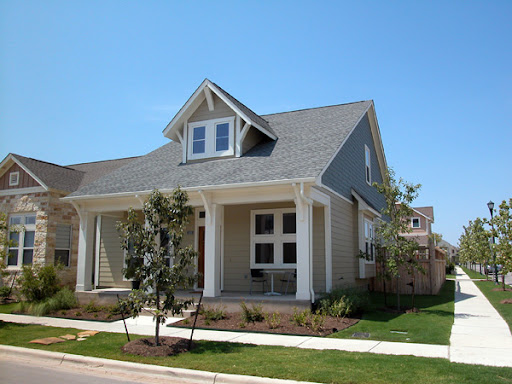
One of our neighbors, Dusty, a master gardener, had recommended spreading compost as an alternative to fertilizing our lawns. We decided to give it a try, and with my parents went out to Texas Disposal Systems to get a truckload of compost, along with a truckload of mulch for the flowerbeds and trees. Their pricing list included Texas Organic Products (TOP) compost, made from clippings, and premium compost. We'd intended to buy the TOP compost, but premium must be better, right? The pricing sheet mentioned that it is used by TxDOT, which sounded like a good enough endorsement for a landscaping product.
The description also included "Class A biosolids." Having no idea what biosolids are, and swayed by the other two points, I ordered the premium stuff. As we transported it back home and spread it over the lawn, I wondered how something presumably made of plant matter smelled so much like manure. The stench lasted for a few days.
Also called Alamo-Gro, the premium compost is made from San Antonio's treated sewage. Gross, but perfectly safe, it has worked wonders for the lawn. Just take a look at the yard of the house under construction across the street and you'll see how impressive the transformation has been.
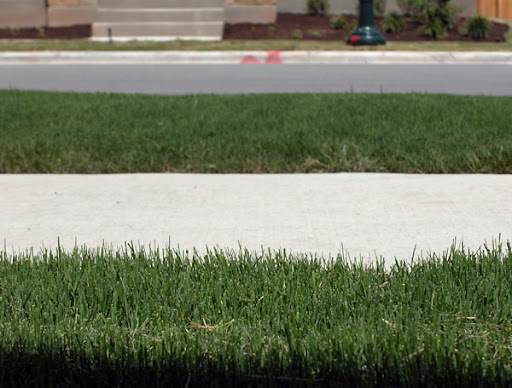
There's construction on both sides of our corner lot. David Weekley Homes is building on Scales (first photo below), and Standard Pacific has houses on McCloskey (second photo). Can you guess which builder started first?
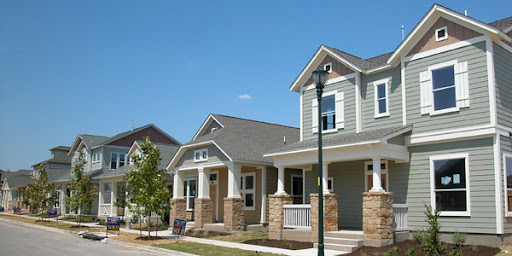
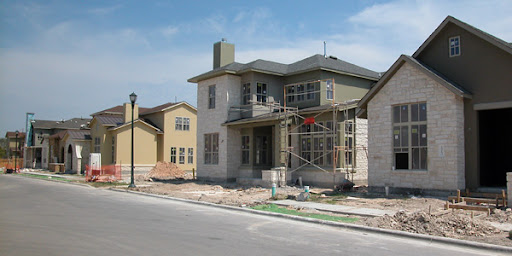
Just before we moved into our home in April, Standard Pacific already had houses framed, while David Weekley's lots were still bare dirt.
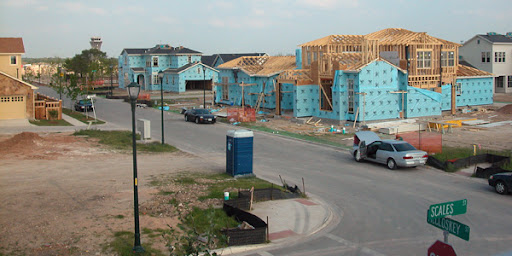
By late May, Weekley had the framing up for the corner lot, with foundations ready to pour down the street. They've gone up in next to no time and will soon be complete, while Standard Pacific's homes seem to move along at a snail's pace. I suppose different builders just have different ways of doing things, but it will be nice when the construction near us is over. I'm looking forward to actually sleeping in again on the weekends. Bad news is that one of the StanPac lots only recently sold, meaning at least 8 more months of torture before they're done.
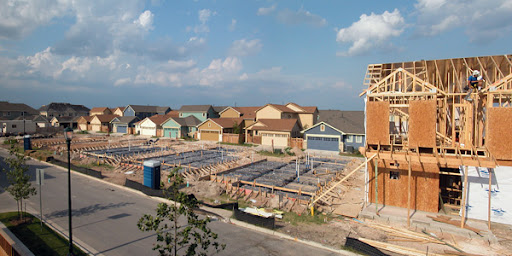
Further afield, some builders have started houses in Phase 2. We'll have to take some photos to share here soon. And on the northern edge of the old airport, construction has started on the water tower for reclaimed water to serve the parks and green spaces of the development.
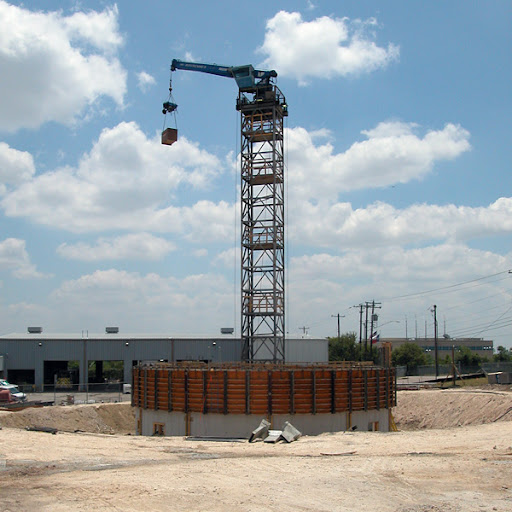
On an unrelated note, I wanted to share more photos of the new light, where you can actually see it in context. It looks great with all the stainless appliances in the kitchen, but the light over the breakfast table has to go. Please share any ideas you have for the replacement. We want something understated, that harmonizes with the vintage fixture but does not compete with it.
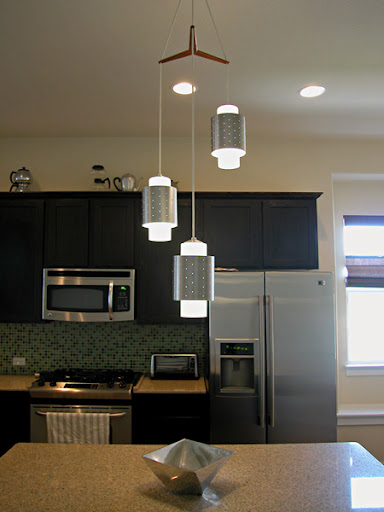

Also, if you want the lamps we're replacing, they're for sale on Craigslist. So far only one spammer has been interested.
6 comments:
Wow. Maybe the smell was worth it. I can't believe how great the yard looks.
Love
Mom-WB
Two things:
1) might want to link to the CL ad in case you have pictures of the old lamps up;
2) as to the compost...well, you know what they say. S*** happens.
Of course, I went there. You would expect anything less?
As sewage treatment plants around the country upgrade from pathogenic Class B sewage sludge "biosolids" to Class A sludge (including "compost"), it becomes harder to find a use for this waste. Most sewage plants give it away for free, as there is little or no commercial market.
All sewage sludge - both Class B and Class A - contains a great deal of industrial waste. The EPA Office of Inspector General issued a highly critical report in 2004 about the fact that industrial pretreatment programs are not being enforced. Sewage plant operators are not strictly controlling the discharge of toxic industrial chemicals into sewers because they fear the added expense of recycling or properly disposing of hazardous wastes could cost local jobs or drive the company to relocate (such as to Mexico, with weak labor and environmental laws - welcoming US companies with open arms)'
The US EPA also acknowledges that Class A sewage sludge "biosolids" "compost" is subject to explosive pathogen regrowth. The most common pathogens which recolonize the sludge are fecal coliforms and salmonellae.
In summer 2007, sludge generated at the wastewater treatment plant in Milwaukee, Wisconsin ( makers of Class A Milorganite "fertilizer") and spread on 30 public parks and playgrounds, contained high levels of toxic PCBs. It cost Milwaukee taxpayers over $4.7 million to scrape the sludge off the land and ship it out of state to a federally approved landfill for hazardous waste. Yet federal regulations do not require testing sludges for PCBs or for many other harmful chemical compounds.
University of Wisconsin scientists have warned the EPA and waste industry of a new risk with land application of both Class B and Class A sewage sludge - infectious prions from human and animal sources. See http://www.sludgevictims.com/pathogens/prion.html for more information.
Because of the well documented risks of pathogen regrowth in Class A sludge compost, as well as significant content of toxic industrial wastes, prions, endotoxins,etc. Class A sludge compost should not be used where children and family pets can come in contact with it such as on home lawns, flower vegetable gardens or in ball parks and public playgrounds.
It is well known that plants, including vegetables, can take up soil and sludge pollutants. And exposure to Class A sludge compost has produced sickness, allergic reactions, respiratory distress, skin lesions, etc. in people around the country. http://www.sludgevictims.com/Class-A-sludge.html
Prudent homeowners might prefer to use soil amendments that truly only contain "nature's trash," such as leaf and yard waste, food scraps, and properly treated animal manures.
Helane Shields, Alton, NH sludge researcher since 1996 http://www.sludgevictims.com
Helane given that most animal manures aren't treat or even analysis I would rather go with the devil I know. Biosolids are monirored and regulated where no other maunure or fertilisers are. If they had to under go the scurity of biosolids Im sure we would find more nasties in them than biosolids.
Give biosolids - and composts a fair go
I have total light envy. The new pendant looks awesome installed!
I need updates. I can't sleep because there are no updates. The voices are getting louder.....LOUDER & LOUDER. Posting an update will quiet the millions of voices in my head. Oh...wait. Is that the TV?
Post a Comment